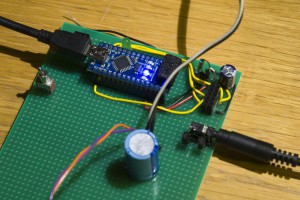

- Arduino camera time lapse operation pdf#
- Arduino camera time lapse operation install#
- Arduino camera time lapse operation download#
- Arduino camera time lapse operation free#
Arduino camera time lapse operation free#
As always, if you have any questions feel free to drop us a line. It should give you a pretty good idea of how our equipment functions and what you can expect out of it. Until then we hope that our data can help you if you’re designing a similar project, in similar conditions. We plan on setting up the same solar GoPro system once the project starts ramping up so we can follow it through completion. We likened it to watching paint dry or grass grow because the contractor didn’t make much visible progress–probably because of the crummy weather. The only downside of our experiment was the wholly unexciting final video. However, the camera was plugged into a USB port on our computer just long enough to extract the data each time, probably 30 minutes total over 68 days.

NOTE: We did not top up the battery with an external source at any point during those 68 days.
Arduino camera time lapse operation pdf#
pdf format here.Īfter we took the setup down we analyzed the photo times and dates which showed all were accounted for, meaning that between the camera and battery there was always enough reserve power for our intended operation. If you want further details you can grab our weather log in. The temperature bottomed out at 4☏ / -15.6☌ on the night of 1/7/14 and about 46 days had freezing temperatures at some point during the day. The average high was around 45☏ / 7.5☌ with an average low of about 33☏ / 0☌. The weather was generally cloudy or hazy with only 14 clear days out of 68.

We agree that this is a little bit excessive but figured we should try to tax the system. We set the intervelometer to take a photo every 20 (1/20/14 – corrected) 10 minutes, 24 hours a day.
Arduino camera time lapse operation download#
We ran the system for 68 days, interacting with it only four times to check the charge level of the camera, battery, and to download the time-lapse videos to get a feel of the progress. If our job was to create the ugliest installation, yet keep the panel locked toward the sun while keeping the enclosure from falling from a seven story building… then we succeeded. The setup consisted of a Voltaic 3.4 watt center hole solar panel, pole mount clamp, a V15 battery, GoPro Hero2 camera (32gb SD card) with a Cam-Do intervalometer and a Cam-Do outdoor enclosure… and a piece of wood we got from the weird hardware store down the block.
Arduino camera time lapse operation install#
It was a clear Fall day in Brooklyn when we made our way up to the roof to install the system. Not have the enclosure fall seven stories on someone or something below (granted, this probably should’ve been goal number one).Get a better idea of how this type of setup behaves in cold and freezing conditions.Explore how our our products could be used for stuff like solar powered trail cams, semi-unattended time lapse applications, and situations where it’s impractical or impossible to access the battery or camera for a month at a time or more.We figured a New York winter would be be a great time to experiment with this. In the past couple years we’ve seen a lot of people using our solar products on GoPro cameras in virtually unattended and/or extreme weather situations. Joking aside, this project was actually sparked by our customers and their questions about product operation in wintry conditions. Some of us have very short attention spans and in order to help other people who suffer from the same ailment, decided to use our solar prowess to compress months worth of activity into mere minutes. Some of us wanted to see what goes into building condos that are about a zillion dollars each.

In November we decided to use solar power to monitor a new condo development across the street from our office.


 0 kommentar(er)
0 kommentar(er)
